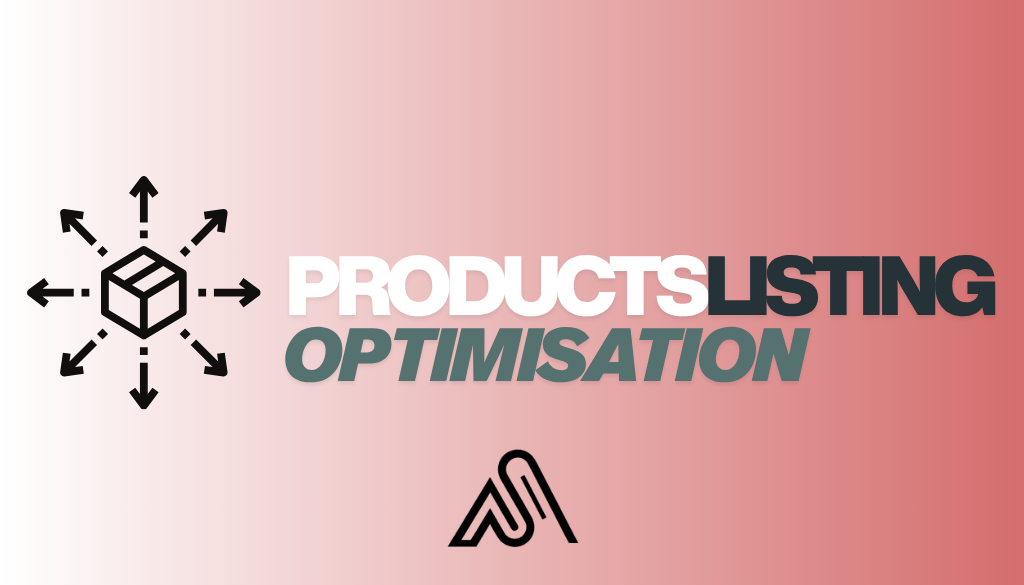In today’s competitive e-commerce landscape, having effective product listings is crucial for standing out and driving sales. With 2.71 billion shoppers globally buying from digital marketplaces in 2024, the opportunity is vast, but so is the competition for visibility in search results.

To help you navigate this challenge, our comprehensive guide will walk you through proven strategies to optimize your product listings across various platforms, improving visibility, click-through rates, and ultimately, boosting sales. For expert assistance, consider consulting with professionals from agenciaseoo
Table of Contents
The Power of Product Listing Optimization in E-commerce
With over 2.71 billion global shoppers making purchases online in 2024, optimizing product listings is crucial for businesses to stand out. As e-commerce continues to expand, the need for effective product listing optimization becomes increasingly vital for online success.
What Is Product Listing Optimization?
Product listing optimization refers to the process of improving the visibility and appeal of product listings on e-commerce platforms. This involves optimizing product titles, descriptions, images, and other elements to make them more search-friendly and attractive to potential customers. By doing so, businesses can improve their product’s ranking in search results, driving more organic traffic to their listings.
Why Product Listing Optimization Matters for Your Business
Optimized product listings significantly improve your visibility in search results, helping you capture a larger share of the massive e-commerce market. When your listings rank higher, you experience increased organic traffic without additional advertising costs, improving your overall ROI. Properly optimized listings also convert at higher rates because they provide shoppers with exactly the information they need, making the purchasing decision easier.
To illustrate the impact of product listing optimization, consider the following comparison:
| Aspect | Non-Optimized Listing | Optimized Listing |
|---|---|---|
| Search Visibility | Low | High |
| Conversion Rate | Lower | Higher |
| Customer Engagement | Minimal | Significant |
For businesses looking to enhance their e-commerce strategy, services like those offered by agenciaseoo.com can provide expert guidance on product listing optimization, helping you stay competitive in the ever-growing digital marketplace.
WHAT’S THE BEST AGENCY THAT CAN OPTIMSE MY PRODUCTS LISTING ?

If your products aren’t ranking high or generating the sales you expect, the problem often lies in how they’re presented online. At Agencia SEO, we specialize in turning underperforming product listings into top-ranking, revenue-generating assets.

Our approach goes beyond simply adding keywords. We start with an in-depth audit of your current listings, identifying missed opportunities in your titles, descriptions, bullet points, and images. We then apply proven SEO for e-commerce techniques to ensure your products appear at the top of search results — both on Google and within marketplace search engines like Amazon.
From crafting keyword-rich, persuasive copy to optimizing your images for maximum click-through rate, every detail is designed to improve both visibility and conversion rates. The result? More traffic, more trust from potential buyers, and a significant increase in sales.
Whether you’re selling on Shopify, WooCommerce, Amazon, or other platforms, our product listing optimization service ensures your store outshines the competition.

Don’t let poorly optimized listings keep you from reaching your sales potential. Get your free product listing audit today and let our experts show you exactly how to transform your product pages into sales magnets.
Understanding Marketplace Algorithms and Search Rankings
Marketplaces like Amazon, eBay, and Walmart use complex algorithms to rank products in search results. These algorithms consider various factors, including product titles, descriptions, customer reviews, and sales history.
Key Factors Influencing Algorithm Rankings
- Relevance: The product’s relevance to the search query is crucial. Sellers should ensure their product titles, descriptions, and keywords accurately reflect the product.
- Customer Reviews: Positive reviews can improve a product’s visibility. Sellers should focus on providing excellent customer service to encourage positive reviews.
- Sales History: A product’s sales history is also an important factor. Sellers should monitor their sales performance and adjust their strategies accordingly.
By understanding how marketplace algorithms work and optimizing product listings, sellers can increase their products’ visibility and sales.
Conducting Effective Product Research
Product research is a critical step in optimizing your product listings for maximum visibility. To create listings that stand out, you need to understand your target audience and analyze your competitors.
Understanding Your Target Audience
Analyzing your target audience is crucial for creating product listings that resonate with potential customers. You need to understand their needs, preferences, and pain points to tailor your listings accordingly. By doing so, you can increase the chances of your product being discovered during a search.
Studying Competitor Listings
Another aspect of this research process is identifying key competitors. Don’t just look at the big players; analyze smaller third-party sellers with surprisingly high rankings for related products. Ask questions like: What are they doing well with titles, bullet points, images, pricing, etc.? Here are some key insights to gather:
- Examine how top-performing competitors structure their titles, what keywords they emphasize, and how they organize their bullet points.
- Pay attention to the language competitors use to describe features and benefits, as well as how they address common customer questions or objections within their listings.
- Use competitor research to identify gaps in the market – what information or selling points are competitors missing that you could highlight in your own listings to stand out?
By analyzing competitor listings that rank well, you can gain invaluable insights into what’s working in your specific product category and marketplace. This information can help you refine your product listings to improve visibility and conversion rates.
Mastering Keyword Research for Product Listings
Effective product listing is crucial for the success of any e-commerce business. By understanding the keywords that your target audience uses, you can optimize your product listings to improve their visibility and drive more sales.
To conduct keyword research, you can use various tools such as Google Keyword Planner, Ahrefs, and SEMrush. These tools provide insights into keyword volume, competition, and suggested bid prices, making it easier to identify the most effective keywords.
When conducting keyword research, consider the following factors: relevance, competition, and search volume. Ensure that the keywords you choose are relevant to your product and target audience.
Crafting Compelling Product Titles That Convert
The art of creating an effective product title lies in balancing search visibility with customer appeal. A well-crafted product title can significantly impact your product’s visibility and sales by enticing customers to click on your listing.
To achieve this balance, it’s essential to understand the best practices for structuring your product titles.
Title Structure Best Practices
A good title should be descriptive, concise, and informative. Here are some key considerations:
- Prioritize your keywords by search volume and relevance, placing the most important terms early in the title.
- Use natural language patterns that incorporate keywords in a way that reads smoothly to potential customers.
- Avoid the common mistake of keyword stuffing, which can trigger marketplace algorithm penalties.
Incorporating Keywords Without Keyword Stuffing
Incorporating relevant keywords in your product title is crucial for search visibility. However, it’s equally important to avoid keyword stuffing. Instead, focus on writing naturally and providing the information your audience is seeking.
To achieve this, test different keyword placements and combinations in your titles to find the optimal balance between search visibility and click-through rates.
By following these best practices and avoiding common pitfalls like keyword stuffing, you can create product titles that not only appeal to search algorithms but also resonate with your target audience, driving conversions and sales.
Amazon Products Optimisation : Creating Persuasive Product Descriptions
Well-written product descriptions play a vital role in informing and persuading potential customers. They provide the necessary information that helps shoppers make informed purchasing decisions.
A good product description not only highlights the features of a product but also explains how these features translate into benefits for the customer. This balance is crucial for creating a compelling narrative that drives sales.
Features vs. Benefits: What Sells Products
When crafting product descriptions, it’s essential to understand whether to focus on features or benefits. While features provide detailed information about a product, benefits explain how those features improve the customer’s life.
For instance, instead of just listing that a smartphone has a long-lasting battery, a benefit-focused description would highlight how this means the customer can enjoy their favorite apps all day without worrying about running out of power.
Using Bullet Points Effectively
Bullet points are a powerful tool for making product descriptions scannable and easy to read. Here are some tips for using bullet points effectively:
- Structure your bullets in order of importance, placing the most compelling benefits and features first.
- Begin each bullet point with a capitalized, benefit-focused phrase that immediately communicates value.
- Keep bullet points concise (ideally 1-2 lines each) while being specific enough to answer common customer questions.
- Use a consistent grammatical structure across all bullet points to create a professional appearance.
By incorporating these strategies into your product descriptions, you can enhance the shopping experience, provide valuable information to your customers, and ultimately drive more sales.
Optimizing Product Images for Maximum Impact

Optimizing product images is a multifaceted process that involves more than just presenting a product; it’s about creating an immersive experience. High-quality product images are crucial for e-commerce success, influencing both customer perception and search engine rankings.
Image Quality Requirements Across Platforms
The quality of product images can significantly vary across different e-commerce platforms. For instance, Amazon requires images to be at least 1000 x 1000 pixels to enable zoom functionality, while other platforms may have different specifications. Ensuring that your product images meet these requirements is essential for a professional and engaging presentation.
Key considerations include: using high-resolution images, optimizing file sizes for web use, and ensuring that images are well-lit and in focus. By adhering to these standards, you can enhance the visual appeal of your product listings and improve customer satisfaction.
Using Alt Text and Metadata for Better Visibility
Alt text and metadata play a critical role in making your product images discoverable by search engines and accessible to all shoppers. Alt text should be a descriptive sentence that includes 1-2 relevant keywords, providing context for both visually impaired customers and search engine algorithms.
- Image optimization goes beyond visual quality – properly formatted metadata and alt text make your images discoverable by search engines and accessible to all shoppers.
- Alt text serves dual purposes: it improves accessibility for visually impaired shoppers using screen readers and provides search engines with contextual information about your images.
- Create descriptive, keyword-rich alt text for each product image that accurately describes what’s shown while naturally incorporating relevant search terms.
- Use descriptive file names for your images before uploading, as these can contribute to search visibility.
- Compress images appropriately to maintain visual quality while ensuring fast page load speeds, which impacts both user experience and search rankings.
Leveraging Customer Reviews and Social Proof
Leveraging customer reviews effectively can significantly enhance the visibility and credibility of your product listings. In today’s competitive e-commerce landscape, customer feedback is invaluable as it serves as social proof that can influence purchasing decisions.
Most marketplaces strive to provide a unique customer experience to elevate trust and credibility and encourage positive reviews for potential buyers. Product listings often highlight aggregated rating scores. To inspire trust, ensure your product has enough positive reviews and social proof to appear reputable at a glance.
Encouraging Positive Reviews
To boost your product’s credibility, it’s essential to encourage satisfied customers to leave positive reviews. While it might seem challenging, there are several strategies you can implement to increase your review count. First, ensure that your product meets high-quality standards and exceeds customer expectations. Then, consider implementing a follow-up email campaign that politely asks customers to share their experiences.
Key strategies include:
- Providing exceptional customer service to naturally encourage positive word-of-mouth
- Following up with customers after a purchase to gather feedback
- Offering incentives, such as discounts on future purchases, for customers who leave reviews
Responding to Negative Feedback
Not all customer experiences will be positive, and negative reviews are an inevitable part of doing business online. However, these reviews present valuable opportunities to demonstrate your commitment to customer satisfaction and build trust with potential buyers. When responding to negative feedback, it’s crucial to do so promptly and professionally.
Best practices include:
- Responding within 24 hours to show that you take customer concerns seriously
- Thanking the customer for their feedback and acknowledging their specific issue
- Apologizing for their negative experience and offering a concrete solution or next steps
- Taking the conversation offline when appropriate to resolve the issue privately
- Politely asking the customer to update their review if the issue is resolved satisfactorily
By effectively leveraging customer reviews and social proof, you can significantly enhance your product listings’ visibility and credibility, ultimately driving more sales and growth for your business.
Pricing Strategies for Product Listing Optimization
Optimizing your product listings requires a deep understanding of pricing strategies. The right pricing can significantly impact your product’s visibility and sales.

Competitive Pricing Analysis
Conducting a competitive pricing analysis is crucial to understanding the market dynamics. Analyze your competitors’ pricing strategies to determine the optimal price for your product. This involves studying the prices of similar products and identifying gaps in the market.
By doing so, you can position your product competitively, ensuring it’s attractive to potential customers while maintaining profitability.
Using Promotions and Discounts to Boost Visibility
Strategic promotions and discounts can dramatically boost product visibility. Here are some key strategies to consider:
- Time-limited promotions create urgency, driving conversions and increasing sales velocity, a key ranking factor.
- Utilize platform-specific promotional tools like Amazon’s Lightning Deals or eBay’s Promotions Manager to maximize visibility.
- Many marketplaces have dedicated “deals” sections that attract bargain hunters, exposing your products to new audiences.
- Track the performance of different promotion types to identify which ones generate the best ROI for your product categories and price points.
By leveraging these strategies, you can improve your product’s ranking and increase sales, ultimately driving business growth.
You can also use Amazon’s Automate Pricing feature to automatically adjust prices across your inventory, ensuring you stay competitive.
Platform-Specific Product Listing Optimization Techniques
Different e-commerce platforms have unique algorithms and requirements, making platform-specific optimization crucial for success. To maximize visibility and sales, businesses must understand the intricacies of each platform’s search algorithms and user behaviors.
For instance, Amazon’s A9 algorithm prioritizes product relevance, customer reviews, and sales history. To optimize listings on Amazon, sellers should focus on:
- Using relevant keywords in product titles and descriptions
- Encouraging customers to leave reviews
- Maintaining competitive pricing
Amazon-Specific Optimization Tips
To improve visibility on Amazon, sellers can leverage Amazon SEO methods and customer engagement best practices. This includes selecting product categories carefully, optimizing listings, and setting competitive prices to enhance sales conversion and Best Sellers Rank.
eBay and Walmart Optimization Strategies
While Amazon dominates the e-commerce landscape, other marketplaces like eBay and Walmart offer significant opportunities. For eBay, sellers should focus on:
- High-quality product images
- Detailed product descriptions
- Competitive pricing and strategic use of promotions
Walmart, on the other hand, emphasizes product relevance and seller performance. To succeed on Walmart’s platform, businesses should prioritize:
- Accurate product categorization
- High-quality product data
- Excellent customer service
Google Shopping and Other Channels
Google Shopping optimization requires a different approach, focusing on structured data implementation and feed quality. Ensuring your product data feed is comprehensive and regularly updated is crucial. Unlike marketplace listings, Google Shopping ads link directly to your website, making landing page experience and site performance critical factors in both ranking and conversion.
To optimize for Google Shopping, businesses should:
- Implement proper schema markup on product pages
- Enhance product listings with rich snippets showing price, availability, and reviews
- Focus on lifestyle imagery and compelling short-form descriptions for social commerce channels like Facebook and Instagram Shops
Working with experts like agenciaseoo.com can help develop channel-specific optimization strategies that maximize visibility across the entire digital ecosystem where your potential customers shop.
| Platform | Optimization Focus | Key Strategies |
|---|---|---|
| Amazon | Relevance, Reviews, Sales History | Keyword optimization, Review encouragement, Competitive pricing |
| eBay | Product Images, Descriptions, Pricing | High-quality images, Detailed descriptions, Strategic promotions |
| Walmart | Product Relevance, Seller Performance | Accurate categorization, High-quality product data, Excellent customer service |
| Google Shopping | Structured Data, Feed Quality | Schema markup, Rich snippets, Comprehensive product data feeds |
Tools and Software for Streamlining Product Listing Optimization

Product listing optimization is a complex task that can be simplified with the appropriate tools and software. In today’s competitive e-commerce landscape, businesses need to ensure their product listings are accurate, consistent, and optimized for various marketplaces.
Digital Asset Management (DAM) Solutions
DAM solutions are crucial for managing the vast array of digital assets associated with product listings. These systems help organize, store, and distribute product images, videos, and other media across different channels.
By centralizing digital assets, DAM solutions ensure that all product listings use the same high-quality images and videos, enhancing brand consistency and customer engagement.
Product Information Management (PIM) Systems
PIM systems serve as the central hub for all product data, creating a single source of truth that ensures consistency across all sales channels. These powerful tools allow you to store, manage, and enrich product information including specifications, descriptions, pricing, categories, and relationships between products.
- Product Information Management (PIM) systems serve as the central hub for all your product data, creating a single source of truth that ensures consistency across all sales channels.
- These powerful tools allow you to store, manage, and enrich product information including specifications, descriptions, pricing, categories, and relationships between products.
- PIM systems excel at handling complex product catalogs with numerous variations, attributes, and specifications that would be unwieldy to manage through spreadsheets or marketplace interfaces.
- The best PIM solutions include built-in validation rules that ensure your product data meets the specific requirements of each marketplace before publication, preventing listing errors.
- Look for PIM systems with robust API capabilities that can seamlessly push updated product information to all your sales channels simultaneously, saving countless hours of manual data entry.
By leveraging DAM and PIM solutions, businesses can significantly streamline their product listing optimization process, ensuring accuracy, consistency, and compliance with marketplace requirements.
Conclusion: Taking Your Product Listings to the Next Level with agenciaseoo.com
As we’ve explored throughout this guide, effective product listing optimization is crucial for success in today’s competitive e-commerce landscape. To stay ahead, it’s essential to continually refine and adapt your product listings to meet the evolving demands of marketplace algorithms and consumer behaviors.
The most successful sellers treat their listings as living documents, regularly analyzing performance data, testing new approaches, and making incremental improvements based on results. While the techniques covered in this guide provide a solid foundation, truly exceptional results often come from working with specialists who understand the nuances of each marketplace platform.
At agenciaseoo, we specialize in developing customized product listing optimization strategies that align with your specific business goals, product categories, and target markets. Our team combines technical expertise in marketplace algorithms with creative copywriting and image optimization to create listings that not only rank well but convert browsers into loyal customers.
Whether you’re just getting started with marketplace selling or looking to take your existing listings to the next level, partnering with agenciaseoo can help you navigate the complexities of product listing optimization and achieve sustainable growth across all your sales channels.
By focusing on optimization techniques that drive sales and improve visibility in search results, you can significantly enhance your overall e-commerce performance. Contact us today to discover how our data-driven approach to product listing optimization can help your products stand out in today’s competitive e-commerce landscape.
FAQ
### Q: What is product listing optimization?
Product listing optimization is the process of improving the visibility and ranking of a product in online marketplaces through various techniques, including keyword research, title and description optimization, and image optimization.
### A: How do I optimize my product title for better visibility?
To optimize your product title, make sure it is descriptive, concise, and includes relevant keywords that customers might use when searching for your product.
### Q: What is the importance of product descriptions in e-commerce?
Product descriptions play a crucial role in e-commerce as they provide customers with detailed information about the product, its features, and benefits, helping them make informed purchasing decisions.
### A: How can I improve my product’s visibility on Amazon?
To improve your product’s visibility on Amazon, optimize your product title, description, and keywords, and ensure that your product is categorized correctly. You can also use Amazon’s advertising options, such as Sponsored Products, to increase visibility.
### Q: What is the difference between short-tail and long-tail keywords?
Short-tail keywords are brief and generic, while long-tail keywords are more specific and less competitive. Using a mix of both can help improve your product’s visibility in search results.
### A: How often should I update my product listings?
It’s essential to regularly update your product listings to reflect changes in your products, customer needs, and market trends. This can help improve your product’s visibility and stay competitive.
### Q: Can I use the same product listing across multiple marketplaces?
While it’s tempting to use the same product listing across multiple marketplaces, it’s not recommended. Each marketplace has its unique requirements, and you should tailor your product listing to meet those specific requirements to maximize visibility and sales.
### Q: How can I measure the effectiveness of my product listings?
You can measure the effectiveness of your product listings by tracking metrics such as click-through rates, conversion rates, and sales. Analyzing these metrics can help you identify areas for improvement and optimize your listings accordingly.



